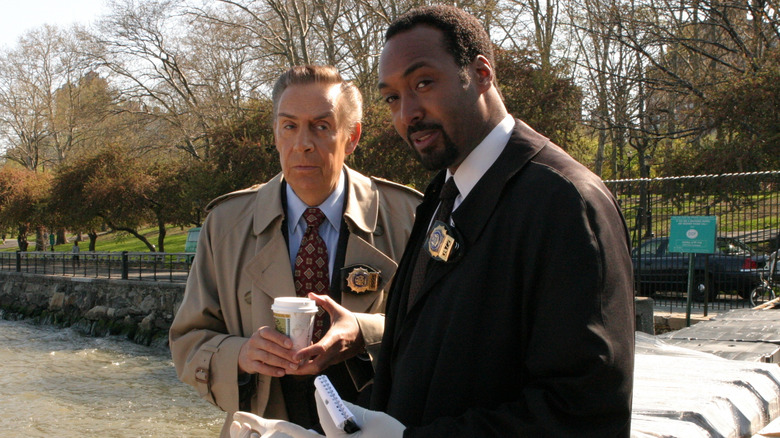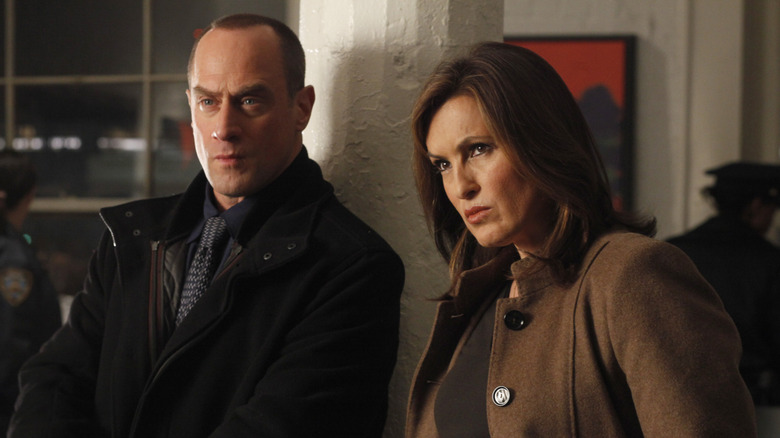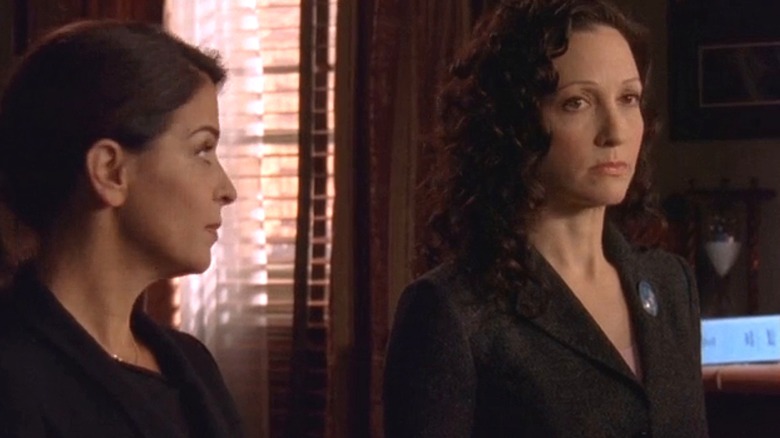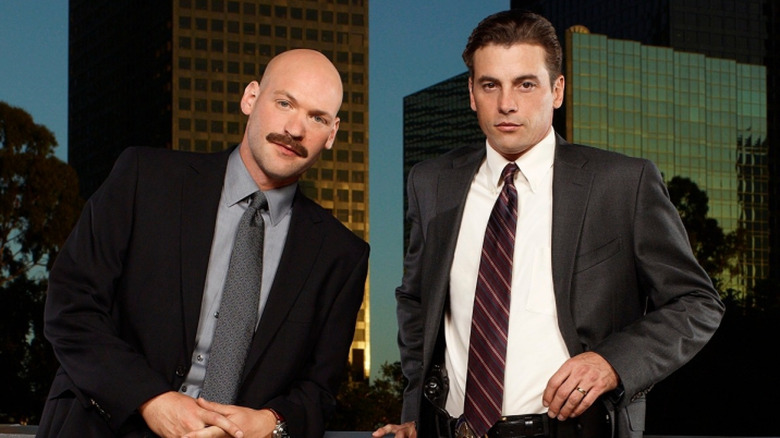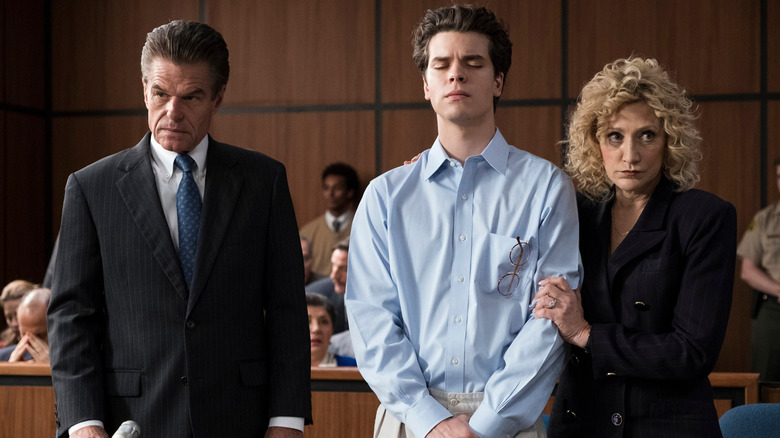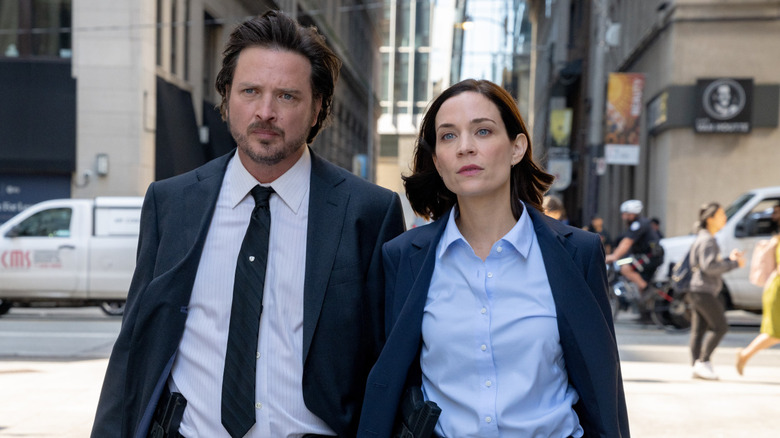Built on a wave of ripped-from-the-headlines crimes, strong and witty writing, and memorable acting, “Law & Order” has thrived for decades thanks to its audience’s deep appreciation of its sometimes-heartbreaking, sometimes-silly reimagining of true criminal cases via fully fictional stories. It’s such a strong brand that it long ago became a full-fledged franchise with multiple series that have proved to be extremely successful and, in some cases, massive failures.
Its legendary status hasn’t ensured the longevity or even the quality of its spin-offs, as the existence of confused shows like “Law & Order: LA” attests. The franchise’s wildly uneven track record when it comes to new series means that “Law & Order” has been attached to and spawned everything from a docuseries based on a brutal real-life crime to a Canada-exclusive show. It birthed a long-lived continuation that’s rarely spoken of these days, as well as a spin-off with a great cast that was quickly canceled even though it can be argued that it deserved better.
All in all, without counting shows that are exclusively broadcast overseas, like “Law & Order: UK,” the detective drama has spawned seven series. That’s a whole lot of television to comb through, and if you’re new to the world of this sprawling detective drama, you may need a little help figuring out where to start. Here, we’ve put together a guide to every single North American-based series that ever budded off of “Law & Order.” We’ve listed the shows in order of debut date for convenience, so if you’re yearning for more justice in your life, this is the place to start.
Law & Order: Special Victims Unit
This is the granddaddy of all “Law & Order” spin-offs, a show that’s so popular and well-received it’s got an audience, following, and spin-off (more on that later) unto itself. With hundreds of episodes and twenty-six seasons (as of this writing) under its belt, “Law & Order: Special Victims Unit” will be back again with new cases for the 2025-2026 season. Centered on the stalwart Olivia Benson (Mariska Hargitay), who has seen fire, rain, and all sorts of pain as she heads up the titular special victims unit, this is a show that’s spawned memes, drinking games, and an incredibly loyal fandom that loves everything it does.
As hinted at by the title, “SVU” deals with sexually based offenses, some of them ripped from real-life headlines and fictionalized into something that’s legally passable to air. The crimes are ugly, sometimes gruesome, and often involve women and children. As with most “Law & Order” series, each episode starts with the discovery of a crime or body and then works through an investigation and court case. Often, the case becomes so complicated that a single trial doesn’t solve the problem.
There have been courtroom shootings, and sometimes the wrong person has been accused of being the perpetrator. People die in messy, often horrific ways, and Olivia regularly questions the strength of her belief in justice. Yet when all the chips are down and the case has been solved, it’s another day in New York City, and Olivia has to keep her wits about her if she wants to survive and keep her position as a top cop.
Law & Order: Criminal Intent
“Law & Order: Criminal Intent” is the second longest-lived “Law & Order” spin-off, lasting for ten seasons until its final episode aired in 2011. It follows the major case squad of the NYPD, whose quarry are the worst criminal offenders the city has to offer. The offenses run the gamut in this spin-off, dealing with everything from death row killers to extremely unusual murders.
“Criminal Intent” added a brand-new twist by showing the audience scenes from the lives of the criminals, offering deeper insight into why they committed their crimes. These vignettes help to explain who they are and why they’ve committed their crimes. Running parallel to these vignettes are your typical “Law & Order” procedural scenes, which include forensic investigations, interrogations of other suspects, and similar “L&O” universe staples. Everything ultimately culminates in an arrest and a trial, but, as always, not every case reaches a happy conclusion. Some perps get away with their crimes or die before justice can be served.
Originally, the spin-off was headed up by Detectives Robert Goren (Vincent D’Onofrio) and Alexandra Eames (Kathryn Erbe). Later, “Law & Order” mainstay Mike Logan (Chris Noth) was thrown into the mix when the show changed formats to split its cases between Goren and Eames and Logan and newbie Carolyn Barek (Annabella Sciorra). When the show changed networks, moving to USA from NBC, Zack Nichols (Jeff Goldblum) was introduced to head two seasons. Unfortunately, juggling the cast didn’t help the show’s ratings. While NBC Universal did what it could — the unusual move of shifting the show to USA was done to ensure its survival — nothing worked. Goren and Eames were even brought back to try to reclaim lost viewers, but it was too late. “Criminal Intent” was canceled in 2011, but it left behind a legacy well worth exploring and plenty of cases to thrill new viewers.
Law & Order: Trial by Jury
Blessed with an excellent cast but not the fortune to utilize their talents for long or in a manner that befits them, the short-lived “Law & Order: Trial By Jury” focuses on the titular trial part of the legal process. The anticipation of waiting for a verdict, the process of building a case, and the witness’ heartbreaking, vibrant testimony all combine to create memorable moments that keep the audience riveted in spite of the short-lived nature of the series.
Tracey Kibre (Bebe Neuwirth) is the center of the action here, and, as the ADA of New York City, she has a lot of support around her. Deputy ADA Kelly Gaffney (Amy Carlson, later of “Blue Bloods” fame) is at her side, and also lending a hand is longtime investigator and “Law & Order” stalwart Lennie Briscoe (Jerry Orbach). (Though the producers had planned on making Lennie a series regular, he only appeared in three of the show’s thirteen episodes before disappearing due to Orbach’s terminal cancer diagnosis.) Lennie works alongside his partner in the field, Hector Salazar (Kirk Acevedo), until Chris Ravell (Scott Cohen) is brought in as Briscoe’s replacement.
On opposing counsel is a “Law & Order” vet, tough-talking DA and constant thorn-in-Tracey’s-side, Arthur Branch (Fred Thompson). Together, they take on a number of twisty cases laden with violence, passion, and greed. Alas, the intrigue wasn’t enough to keep audiences watching, and “Trial by Jury” was canceled while Season 1 was still airing. Though it only lasted a season, it hardly ruined the franchise, as it incorporated plenty of “Law & Order” crossover material, making it a vital rewatch for fans.
Law & Order: LA
Unfortunately, “Law & Order” fans didn’t love Los Angeles, and this attempt at expanding the franchise out of New York City and making it a West Coast affair bit the dust after a single season. Behind-the-scenes chaos prevented the show from developing into something worthwhile, and several premise changes within a twenty-two-episode span didn’t exactly help. NBC tried to save the show by putting it on hiatus and retooling it, but multiple attempts at fixing the series failed, and it was ultimately canceled.
“Law & Order: LA” initially built itself around LAPD detective Rex Winters (Skeet Ulrich) and his partner, Tomas “TJ” Jaruszalski (Corey Stoll), who report to Senior Deputy DA Ricardo Morales (Alfred Molina). Together, they solve your typical “L&O”-style cases, laden with murder, abuse, kidnappings, and more, with some of the episodes’ stories coming right from the real world.
It’s all smooth sailing until, nine episodes in, Winters is murdered in a drive-by shooting. Morales is horrified and, frustrated with how the LAPD responds to the crime, he decides to return to the field as a detective to bring in the killer all by himself. DDA Connie Rubirosa (Alana de la Garza) takes over Morales’ position while Morales becomes Jaruszalski’s new partner. This lasts for eight episodes, until Morales is suspended from the force. Jaruszalsaki is now in charge of clearing his partner’s name and leaves town to do so — but the audience is never given a resolution to the crime. Instead, the rest of the season flashes back to cases Winters solved while he was still alive.
All of this happened during a single twenty-two-episode season, which led to audience confusion and fatigue. Either way, the franchise soon largely retreated back to the East Coast and didn’t attempt another expansion into a new North American locale for a while.
Law & Order: True Crime
And now we come to the aforementioned docuseries experiment. Since the “Law & Order” brand is based upon real cases that are loosely twisted into fiction, why not take real-life crimes, reenact them, and then broadcast them in televised chunks under the “Law & Order” umbrella? “Law & Order: True Crime” tried to do just that, removing the thin veil of fictionalization that has always been a hallmark of the franchise. Unfortunately, fans didn’t cotton to this juxtaposition between real-world horrors and their favorite fictional reality, and the show was placed on an indefinite hiatus that has not abated.
The show’s sole season focused on the Menendez brothers murders, casting Edie Falco as Leslie Abramson, Gus Halper as Erik Menendez, and Miles Gaston Villanueva as Lyle Menendez, with Anthony Edwards, Harry Hamlin, and Lolita Davidovich rounding out the cast. The season follows the story from the murders of Kitty (Davidovich) and José Menendez (Carlos Gómez) to the reading of the case’s verdict, with the story primarily playing out through Abramson’s eyes as she struggles with the weight of guiding the brothers through their trauma and the trial.
Even though it died quickly, “True Crime” aired before its time, presaging similar and much more successful anthology shows like “American Crime Story” and “Monster.” While Ryan Murphy would eventually take the Menendez brothers’ case and turn up the sex and violence quotient, taking full advantage of the fact that “Monster” is on a streamer like Netflix, “True Crime” opened a lot of doors for the genre. Though its state remains somewhat nebulous, it left an impact on the television world.
Law & Order: Organized Crime
It’s a rare thing for a spin-off to beget a spin-off, but that’s exactly what “Law & Order: SUV” managed to do when it gave birth to “Law & Order: Organized Crime.” The mob-based procedural focuses on beloved longtime “SVU” character Elliot Stabler (Christopher Meloni) who finds himself rejoining the NYPD in the wake of the car bombing slaughter of his wife, which has ties to organized crime and a man Stabler put away decades ago.
He joins the Organized Crime Task Force to track down Kathy’s murderer, who is revealed to be mafia-involved Richard Wheatley (Dylan McDermott), husband of Angela Wheatley (Tamara Taylor), who was looking for revenge on Stabler because she blames him for her own son’s murder. Once the case is solved, Stabler sticks with the OCTF and slowly comes to care about his colleagues while unraveling several criminal empires.
“Organized Crime” is unique in the “Law & Order” world for two reasons. The first is that it’s one of very few shows within the “L&O” universe that tends to follow a single case through an entire season, making it much less episodic than “SVU.” The second is that it’s the only “Law & Order” series to make a home for itself on streaming after being canceled by NBC. Much like “Criminal Intent’s” shift to cable to ensure its survival, “Organized Crime” was moved to Peacock for its fifth season, which is ongoing as of this writing; it hasn’t been announced if it will see a sixth season.
Law & Order: Toronto: Criminal Intent
The newest kid on the “L&O” block is “Law & Order: Toronto: Criminal Intent,” which is a unique concept in the “Law & Order” franchise in that it’s a Canada-exclusive series that is not first-run in the United States. Airing on the cross-Canada cable network CityTV, this spin-off focuses on crimefighting on the mean streets of Toronto. It just wrapped its second season this past spring and has already been renewed for a third season to air in the fall.
Like the original “Law & Order,” the Toronto-based series pushes fictionalized versions of real crimes to its narrative forefront. Most of the crimes are, naturally, notorious Canadian cases that have been solved or remain mysteries that bedevil police officers to this day. Detective Sergeant Henry Graff (Aden Young) and Detective Sergeant Frankie Bateman (Kathleen Munroe) are the show’s two central detectives, and also frequently on the scene are Deputy Crown Attorney Theo Forrester (K. C. Collins) and Inspector Vivienne Holness (Karen Robinson).
Whether it’s figuring out who slew a tech giant or who killed a humble insurance salesman — who, naturally, is hiding a huge secret behind his humdrum existence — the twosome are on the case and, apparently, will be so for some time. Even better news for American fans: the show will soon be broadcast on The CW.

